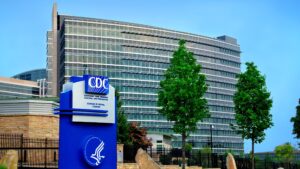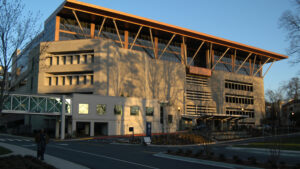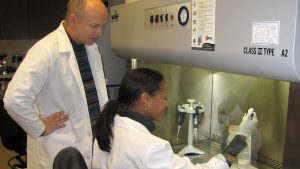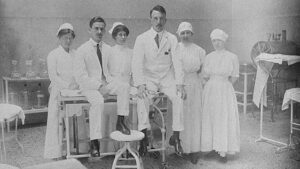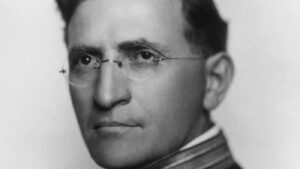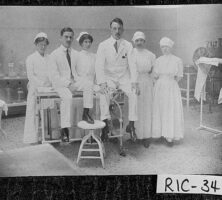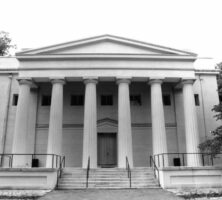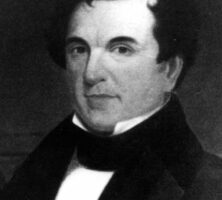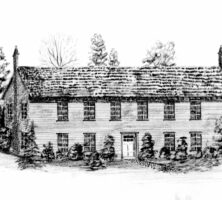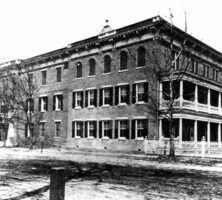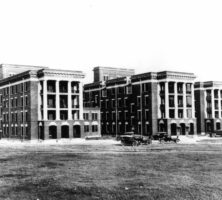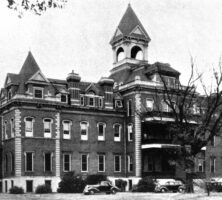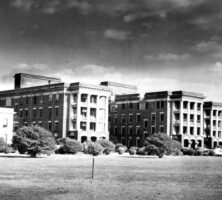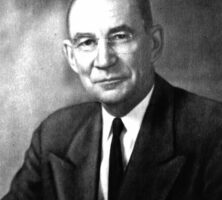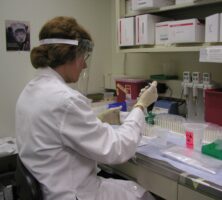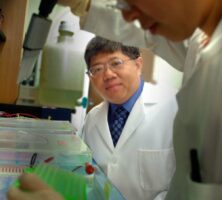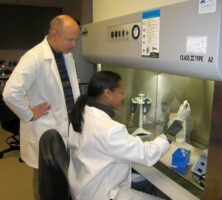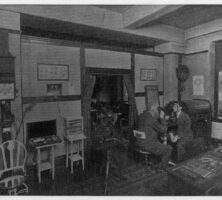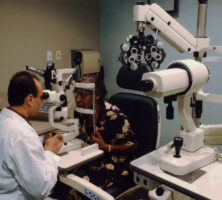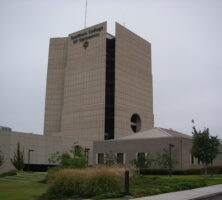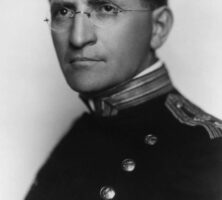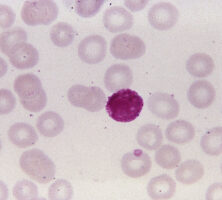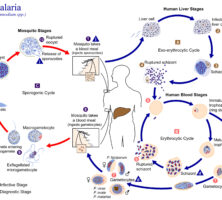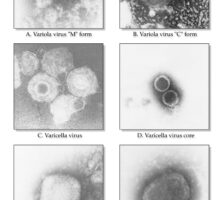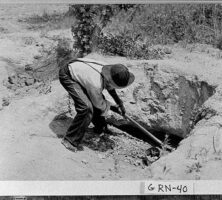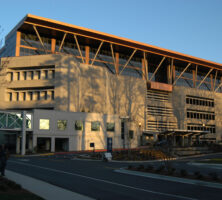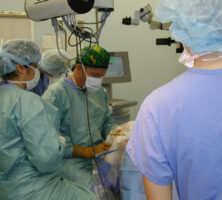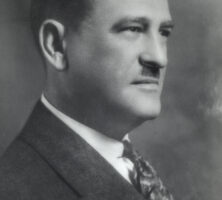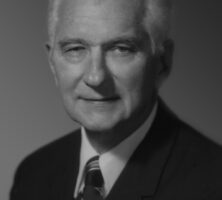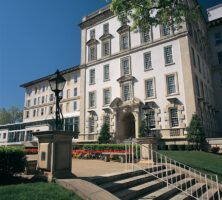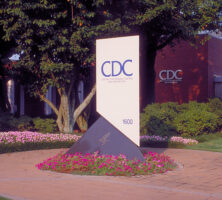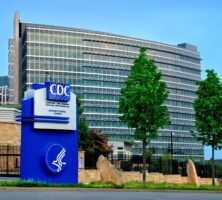The New Georgia Encyclopedia is supported by funding from A More Perfect Union, a special initiative of the National Endowment for the Humanities.
Members of the operating room staff at the Medical Department of UGA (later Georgia Health Sciences University) in Augusta are pictured in the early 1900s.
Courtesy of Georgia Archives, Vanishing Georgia, #
ric034.
The New Georgia Encyclopedia does not hold the copyright for this media resource and can neither grant nor deny permission to republish or reproduce the image online or in print. Requests for permission to publish or reproduce the resource should be submitted to the Georgia Archives.
The original building on the campus of Georgia Health Sciences University, completed in Augusta in 1837, was designed by the architect Charles B. Cluskey. The structure, Cluskey's first major building, is an excellent example of the Greek revival style.
Courtesy of Georgia Health Sciences University
The New Georgia Encyclopedia does not hold the copyright for this media resource and can neither grant nor deny permission to republish or reproduce the image online or in print. All requests for permission to publish or reproduce the resource must be submitted to the rights holder.
The New Georgia Encyclopedia does not hold the copyright for this media resource and can neither grant nor deny permission to republish or reproduce the image online or in print. All requests for permission to publish or reproduce the resource must be submitted to the rights holder.
Milton M. Antony, a physician in Augusta, was instrumental in the 1828 founding of the Medical Academy of Georgia, which later became Georgia Health Sciences University.
Courtesy of Historical Collections and Archives, Robert B. Greenblatt, M.D. Library, Georgia Health Sciences University
The New Georgia Encyclopedia does not hold the copyright for this media resource and can neither grant nor deny permission to republish or reproduce the image online or in print. All requests for permission to publish or reproduce the resource must be submitted to the rights holder.
The city hospital in Augusta, built in 1818, served as the first home for Georgia Health Sciences University, from 1828 until the mid-1830s.
Courtesy of Historical Collections and Archives, Robert B. Greenblatt, M.D. Library, Georgia Health Sciences University
The New Georgia Encyclopedia does not hold the copyright for this media resource and can neither grant nor deny permission to republish or reproduce the image online or in print. All requests for permission to publish or reproduce the resource must be submitted to the rights holder.
The New Georgia Encyclopedia does not hold the copyright for this media resource and can neither grant nor deny permission to republish or reproduce the image online or in print. All requests for permission to publish or reproduce the resource must be submitted to the rights holder.
A new city hospital in Augusta, which opened in 1869 and served for many years as the clinical training site for students at the Medical Department of UGA (later Georgia Health Sciences University), is pictured in 1894, following a renovation.
Courtesy of Historical Collections and Archives, Robert B. Greenblatt, M.D. Library, Georgia Health Sciences University
The New Georgia Encyclopedia does not hold the copyright for this media resource and can neither grant nor deny permission to republish or reproduce the image online or in print. All requests for permission to publish or reproduce the resource must be submitted to the rights holder.
University Hospital, completed in Augusta in 1915, was built for the Medical Department of UGA (later Georgia Health Sciences University) with the city's backing.
Courtesy of Historical Collections and Archives, Robert B. Greenblatt, M.D. Library, Georgia Health Sciences University
The New Georgia Encyclopedia does not hold the copyright for this media resource and can neither grant nor deny permission to republish or reproduce the image online or in print. All requests for permission to publish or reproduce the resource must be submitted to the rights holder.
The Newton Building, on the campus of the Medical College of Georgia (later Georgia Health Sciences University) in Augusta, was occupied by the college from 1913 until 1956. The structure was demolished in 1960.
Courtesy of Historical Collections and Archives, Robert B. Greenblatt, M.D. Library, Georgia Health Sciences University
The New Georgia Encyclopedia does not hold the copyright for this media resource and can neither grant nor deny permission to republish or reproduce the image online or in print. All requests for permission to publish or reproduce the resource must be submitted to the rights holder.
University Hospital, part of Georgia Health Sciences University in Augusta, was expanded in the mid-1930s as part of an effort to restore the good rating of the college and its membership in the Association of American Medical Colleges.
Courtesy of Historical Collections and Archives, Robert B. Greenblatt, M.D. Library, Georgia Health Sciences University
The New Georgia Encyclopedia does not hold the copyright for this media resource and can neither grant nor deny permission to republish or reproduce the image online or in print. All requests for permission to publish or reproduce the resource must be submitted to the rights holder.
G. Lombard Kelly served as dean of the Medical College of Georgia (later Georgia Health Sciences University) from 1934 until 1950, and as the college's first president from 1950 to 1953.
Courtesy of Historical Collections and Archives, Robert B. Greenblatt, M.D. Library, Georgia Health Sciences University
The New Georgia Encyclopedia does not hold the copyright for this media resource and can neither grant nor deny permission to republish or reproduce the image online or in print. All requests for permission to publish or reproduce the resource must be submitted to the rights holder.
The Eugene Talmadge Memorial Hospital in Augusta, built by the state for the Medical College of Georgia (later Georgia Health Sciences University), opened in June 1956 with six buildings.
Courtesy of Historical Collections and Archives, Robert B. Greenblatt, M.D. Library, Georgia Health Sciences University
The New Georgia Encyclopedia does not hold the copyright for this media resource and can neither grant nor deny permission to republish or reproduce the image online or in print. All requests for permission to publish or reproduce the resource must be submitted to the rights holder.
Rhesus macaques are among the seven species of nonhuman primates studied at the Yerkes National Primate Research Center, based in Atlanta at Emory University. These macaques are pictured at the center's field station in Lawrenceville.
Courtesy of Yerkes National Primate Research Center
The New Georgia Encyclopedia does not hold the copyright for this media resource and can neither grant nor deny permission to republish or reproduce the image online or in print. All requests for permission to publish or reproduce the resource must be submitted to the rights holder.
The main center of the Yerkes National Primate Research Center comprises the Neuroscience Building (left), the original building (center), and the Emory Vaccine Center (right). Emory University assumed ownership of the center in 1956.
Courtesy of Yerkes National Primate Research Center
The New Georgia Encyclopedia does not hold the copyright for this media resource and can neither grant nor deny permission to republish or reproduce the image online or in print. All requests for permission to publish or reproduce the resource must be submitted to the rights holder.
Robert Mearns Yerkes, pictured in Orange Park, Florida, founded the Yale Laboratories of Primate Biology in New Haven, Connecticut, in 1928. A year later the facility moved to Orange Park, where it remained until Yerkes's death in 1956. The center was renamed in his honor and relocated to Emory University in Atlanta that same year.
Courtesy of Yerkes National Primate Research Center
The New Georgia Encyclopedia does not hold the copyright for this media resource and can neither grant nor deny permission to republish or reproduce the image online or in print. All requests for permission to publish or reproduce the resource must be submitted to the rights holder.
A researcher at the Yerkes National Primate Research Center, based at Emory University in Atlanta, works in the Biomarkers Core laboratory. The biomedical research conducted at the center helps to provide treatment and prevention strategies for human illnesses.
Courtesy of Yerkes National Primate Research Center
The New Georgia Encyclopedia does not hold the copyright for this media resource and can neither grant nor deny permission to republish or reproduce the image online or in print. All requests for permission to publish or reproduce the resource must be submitted to the rights holder.
Jin-Xiong She, the director of the Center for Biotechnology and Genomic Medicine at the Medical College of Georgia (later Georgia Health Sciences University) in Augusta, observes a researcher at work, circa 2006. The center engages in interdisciplinary research to develop treatments for such diseases as diabetes and cancer.
Photograph by Phil Jones
The New Georgia Encyclopedia does not hold the copyright for this media resource and can neither grant nor deny permission to republish or reproduce the image online or in print. All requests for permission to publish or reproduce the resource must be submitted to the rights holder.
Mark Bouzyk, director of the Center for Medical Genomics at Emory University, watches a research assistant prepare samples for DNA extraction. Emory supports one of the nation's largest academic genetics departments.
Photograph by Janet Nichols
The New Georgia Encyclopedia does not hold the copyright for this media resource and can neither grant nor deny permission to republish or reproduce the image online or in print. All requests for permission to publish or reproduce the resource must be submitted to the rights holder.
Georgia Health Sciences University in Augusta supports the Center for Biotechnology and Genomic Medicine, which promotes genomics, proteomics, and bioinformatics research in an interdisciplinary setting.
Photograph by Phil Jones
The New Georgia Encyclopedia does not hold the copyright for this media resource and can neither grant nor deny permission to republish or reproduce the image online or in print. All requests for permission to publish or reproduce the resource must be submitted to the rights holder.
An optometrist examines a patient in 1915. The Georgia Optical Association (now the Georgia Optometric Association) was founded in 1904, and the first state regulatory laws for optometry were passed in 1916.
Courtesy of American Optometric Association
The New Georgia Encyclopedia does not hold the copyright for this media resource and can neither grant nor deny permission to republish or reproduce the image online or in print. All requests for permission to publish or reproduce the resource must be submitted to the rights holder.
A patient in 2004 undergoes an eye examination. Advances in technology over the last century have expanded the capabilities of optometrists to diagnose and treat various eye conditions. With around 860 licensed optometrists working in more than 150 counties in the state, Georgians have wide access to these services.
Courtesy of Southern College of Optometry
The New Georgia Encyclopedia does not hold the copyright for this media resource and can neither grant nor deny permission to republish or reproduce the image online or in print. All requests for permission to publish or reproduce the resource must be submitted to the rights holder.
Southern College of Optometry in Memphis, Tennessee, is one of four optometry schools in the Southeast. Because an optometry school does not exist in Georgia, the state covers out-of-state tuition costs for Georgia students who are accepted at Southern College.
Image from Halpaugh
The New Georgia Encyclopedia does not hold the copyright for this media resource and can neither grant nor deny permission to republish or reproduce the image online or in print. All requests for permission to publish or reproduce the resource must be submitted to the rights holder.
After observing mill towns, mental hospitals, and orphanages in the South, epidemiologist Joseph Goldberger determined that malnutrition was the cause of pellagra. Goldberger's work led other doctors to discover the exact cause of the disease, a niacin deficiency.
Courtesy of Centers for Disease Control and Prevention
The New Georgia Encyclopedia does not hold the copyright for this media resource and can neither grant nor deny permission to republish or reproduce the image online or in print. All requests for permission to publish or reproduce the resource must be submitted to the rights holder.
A Stearman biplane sprays an insecticide during malaria control operations in Savannah.
Courtesy of Centers for Disease Control and Prevention, Department of Health and Human Services
The New Georgia Encyclopedia does not hold the copyright for this media resource and can neither grant nor deny permission to republish or reproduce the image online or in print. All requests for permission to publish or reproduce the resource must be submitted to the rights holder.
This thin film micrograph depicts an immature cell of the protozoan species that produces malaria; it is magnified 1,125 times.
Courtesy of Centers for Disease Control and Prevention, Department of Health and Human Services
The New Georgia Encyclopedia does not hold the copyright for this media resource and can neither grant nor deny permission to republish or reproduce the image online or in print. All requests for permission to publish or reproduce the resource must be submitted to the rights holder.
Illustration of the life cycle of the parasites of the genus Plasmodium, which are the causal agents of malaria.
Courtesy of Centers for Disease Control and Prevention, Department of Health and Human Services
The New Georgia Encyclopedia does not hold the copyright for this media resource and can neither grant nor deny permission to republish or reproduce the image online or in print. All requests for permission to publish or reproduce the resource must be submitted to the rights holder.
A Malaria Control in War Areas building in Newtown, 1953. The MCWA was created during World War II to help control the spread of malaria, carried by mosquitoes, in the South, particularly in areas around military bases
Courtesy of Centers for Disease Control and Prevention, Department of Health and Human Services
The New Georgia Encyclopedia does not hold the copyright for this media resource and can neither grant nor deny permission to republish or reproduce the image online or in print. All requests for permission to publish or reproduce the resource must be submitted to the rights holder.
Electron micrographs of variola, varicella, and vaccinia virions, or infectious particles of the virus cells.
Courtesy of Centers for Disease Control and Prevention, Department of Health and Human Services
The New Georgia Encyclopedia does not hold the copyright for this media resource and can neither grant nor deny permission to republish or reproduce the image online or in print. All requests for permission to publish or reproduce the resource must be submitted to the rights holder.
The New Georgia Encyclopedia does not hold the copyright for this media resource and can neither grant nor deny permission to republish or reproduce the image online or in print. All requests for permission to publish or reproduce the resource must be submitted to the rights holder.
Pictured in 1941, an African American man digs for white clay in Siloam, Greene County. Photograph by Jack Delano for the Farm Security Administration.
Courtesy of Georgia Archives, Vanishing Georgia, #
grn040.
The New Georgia Encyclopedia does not hold the copyright for this media resource and can neither grant nor deny permission to republish or reproduce the image online or in print. Requests for permission to publish or reproduce the resource should be submitted to the Georgia Archives.
The Emory Eye Center is currently in the top ten eye-research institutions in the country in the amount of funds granted by the National Institutes of Health.
Courtesy of Emory Eye Center
The New Georgia Encyclopedia does not hold the copyright for this media resource and can neither grant nor deny permission to republish or reproduce the image online or in print. All requests for permission to publish or reproduce the resource must be submitted to the rights holder.
Emory Eye Center continues to practice cutting-edge surgery and research on eyes, much as it has since its inception in 1872.
Courtesy of Emory Eye Center
The New Georgia Encyclopedia does not hold the copyright for this media resource and can neither grant nor deny permission to republish or reproduce the image online or in print. All requests for permission to publish or reproduce the resource must be submitted to the rights holder.
Grady Clay developed an academic program for ophthalmology students and for eye, ear, nose, and throat resident physicians. Clay served as department chair at Emory School of Medicine from 1940 until 1946.
Courtesy of Emory Eye Center
The New Georgia Encyclopedia does not hold the copyright for this media resource and can neither grant nor deny permission to republish or reproduce the image online or in print. All requests for permission to publish or reproduce the resource must be submitted to the rights holder.
F. Phinizy Calhoun Jr. served as chair of the Emory School of Medicine Ophthalmology Department from 1946 until 1978. During his tenure he helped open an eye bank, the fifth in the United States, to serve patients in the Southeast who needed cornea transplants. He is credited with bringing modern ophthalmology to Georgia.
Courtesy of Emory Eye Center
The New Georgia Encyclopedia does not hold the copyright for this media resource and can neither grant nor deny permission to republish or reproduce the image online or in print. All requests for permission to publish or reproduce the resource must be submitted to the rights holder.
Emory University Hospital, located on the campus of Emory University in Atlanta, is a tertiary care facility. Staffed by 1500 physicians, the facility has been the site of several important milestones in the medical history of Georgia, including the performance of the state's first heart, kidney, and lung transplants.
Courtesy of Emory University Hospital
The New Georgia Encyclopedia does not hold the copyright for this media resource and can neither grant nor deny permission to republish or reproduce the image online or in print. All requests for permission to publish or reproduce the resource must be submitted to the rights holder.
The new free-standing facility for the John B. Amos Cancer Center of the Columbus Regional Healthcare System was dedicated in 2004. The center was established through an endowment provided by Aflac cofounder John Amos in 1990; he died of lung cancer that same year.
Courtesy of Aflac
The New Georgia Encyclopedia does not hold the copyright for this media resource and can neither grant nor deny permission to republish or reproduce the image online or in print. All requests for permission to publish or reproduce the resource must be submitted to the rights holder.
By 1992 the Center for Disease Control had expanded far beyond communicable diseases, and the agency's name was changed to the Centers for Disease Control and Prevention. (The acronym remained CDC by law.)
Courtesy of Centers for Disease Control and Prevention
The New Georgia Encyclopedia does not hold the copyright for this media resource and can neither grant nor deny permission to republish or reproduce the image online or in print. All requests for permission to publish or reproduce the resource must be submitted to the rights holder.
The Centers for Disease Control and Prevention headquarters are located on Clifton Road in Atlanta. CDC is the nation's premier public health agency and a unit of the U.S. Department of Health and Human Services.
Image from James Gathany, Centers for Disease Control and Prevention
The New Georgia Encyclopedia does not hold the copyright for this media resource and can neither grant nor deny permission to republish or reproduce the image online or in print. All requests for permission to publish or reproduce the resource must be submitted to the rights holder.
In 1947 Emory University donated fifteen acres of land on Clifton Road for the new CDC headquarters, but construction did not begin for more than a decade.
Courtesy of Centers for Disease Control and Prevention
The New Georgia Encyclopedia does not hold the copyright for this media resource and can neither grant nor deny permission to republish or reproduce the image online or in print. All requests for permission to publish or reproduce the resource must be submitted to the rights holder.
The Clifton Road headquarters for the Centers for Disease Control and Prevention in Atlanta was under construction in 1959.
Courtesy of Centers for Disease Control and Prevention
The New Georgia Encyclopedia does not hold the copyright for this media resource and can neither grant nor deny permission to republish or reproduce the image online or in print. All requests for permission to publish or reproduce the resource must be submitted to the rights holder.
A nurse delivering immunization injections to school children in 1948. The vaccines against Diptheria, Tetnus and Pertussis were combined in 1948 which became known as the DTP vaccine.
Courtesy of Nova Jane McCombs and Georgia Department of Human Resources, Division of Public Health
The New Georgia Encyclopedia does not hold the copyright for this media resource and can neither grant nor deny permission to republish or reproduce the image online or in print. All requests for permission to publish or reproduce the resource must be submitted to the rights holder.

